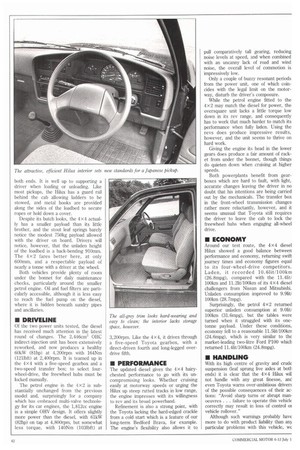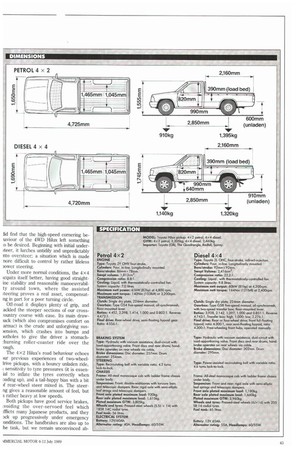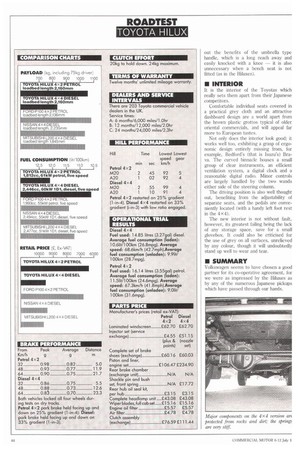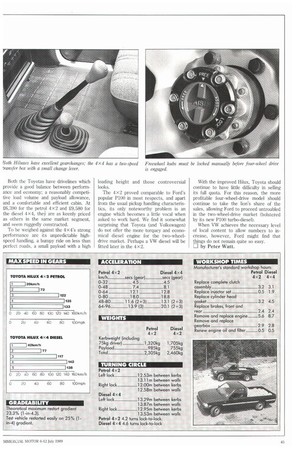ONE TONNE
Page 43

Page 44

Page 45

Page 46

Page 47

If you've noticed an error in this article please click here to report it so we can fix it.
A back-to-back test of Toyota's Hilux pickups; the bashful 4 < 2 petrol and the intimidating 4 4 diesel. Does their performance match their looks?
• Solving your image problem with a pickup may seem as bizarre as fighting the flab with a fork-lift. But in some parts of the world, notably the USA, the pickup is established as one of the leading forms of streetwise locomotion, blurring the boundaries between commercial vehicles and leisure vehicle.
The Japanese, past masters of niche marketing, were quick to latch on to this trend, and have filled the market with a host of increasingly bold one-tonne trucks. Toyota has been no exception, and there are definite suggestions of style-conscious design in our test vehicles this week; a brace of Hilux pickups in petrol 4x 2 and diesel 4 x 4 forms.
This is particularly true of the highriding, hard-hitting, big-selling 4x4 version (which finds six times as many buyers as the 4x2 in the UK). In Toyota's words: "A front grille with integral spoiler, flared wheel arches, revised graphics and those stylish wheels add up to rugged good looks."
Which is all very well but, despite their high-profile appearance, the Hiluxes are billed as working vehicles. Since Toyota began selling a substantially revised version of its pickup in March, we felt this was a good opportunity to scratch beneath the surface gloss to see how the Hilux delivers the goods.
Of added significance is the fact that towards the tail end of the year the first Hilux pickups will be arriving on our shores badged as Volkswagen Taros, following a co-operative agreement between the two companies.
Also, two-wheel-drive models for both manufacturers are being made at VW's Hanover plant, with the prospect that the local content of the product will be increased beyond 60% during 1990 (probably by incorporating a VW driveline), thus escaping the clutches of the quota system which restricts the sales of Japanese products in the EC.
• BODYWORK
The latest Hiluxes have similar lines to their predecessors, but the more rounded bodywork is new. Although both are unmistakably Japanese, the 4x2 and 4x4 have distinct images: the two-wheel-drive model looks rather sheepish, perhaps aimed at the bashful builders: the allwheel-driver provokes the opposite reaction, sitting intimidatingly high on its 16in wheels, and offering a "king-of-the-road" ride to ostentatious operators.
Toyota has devoted a lot of effort to design the Hilux to combat corrosion, and the double-skinned loadbed which is common to both versions appears ruggedly constructed. At 2.16m long and 1.47m wide, the ribbed platform offers as much space as most competitors; we would, however, recommend the use of a load liner to prevent the paint being rubbed off by the load.
The tailgate is released by a central handle and secured by metal straps at both ends. It is well up to supporting a driver when loading or unloading. Like most pickups, the Hilux has a guard rail behind the cab allowing ladders to be stowed, and metal hooks are provided along the sides of the loadbed to secure ropes or hold down a cover.
Despite its butch looks, the 4 x4 actually has a smaller payload than its little brother, and the stout leaf springs barely notice the modest 750kg payload allowed with the driver on board. Drivers will notice, however, that the unladen height of the loadbed is a back-bending 910mm. The 4x2 fares better here, at only 600mm, and a respectable payload of nearly a tonne with a driver at the wheel.
Both vehicles provide plenty of room under the bonnet for daily maintenance checks, particularly around the smaller petrol engine. Oil and fuel filters are particularly accessible, although it is less easy to reach the fuel pump on the diesel, where it is hidden beneath sundry pipes and ancillaries.
• DRIVELINE
Of the two power units tested, the diesel has received much attention in the Latest round of changes. The 2,446ce OHC indirect-injection unit has been extensively reworked, and now produces a healthy 60kW (81hp) at 4,200rpin with 164Nm (1211bft) at 2,400rpm. It is teamed up in the 4x4 with a five-speed gearbox and a two-speed transfer box; to select fourwheel-drive, the freewheel hubs must be locked manually.
The petrol engine in the 4x2 is substantially unchanged from the previous model and, surprisingly for a company which has embraced multi-valve technology for its car engines, the 1,812cc engine is a simple OHV design. It offers slightly more power than the diesel, with 61kW (82hp) on tap at 4,800rpm, but somewhat less torque, with 140Nm (1031bft) at 3,200rpm. Like the 4 x4, it drives through a five-speed Toyota gearbox, with a direct-driven fourth and long-legged overdrive fifth.
• PERFORMANCE
The updated diesel gives the 4x4 hairychested performance to go with its uncompromising looks. Whether cruising easily at motorway speeds or urging the Hilux up steep rutted tracks in low range, the engine impresses with its willingness to rev and its broad powerband.
Refinement is also a strong point, with the Toyota lacking the hard-edged crackle from a cold start which is a feature of our long-term Bedford Brava, for example. The engine's flexibility also allows it to pull comparatively tall gearing, reducing noise levels at speed, and when combined with an uncanny lack of road and wind noise, the overall level of commotion is impressively low.
Only a couple of buzzy resonant periods from the power unit, one of which coincides with the legal limit on the motorway, disturb the driver's composure.
While the petrol engine fitted to the 4x2 may match the diesel for power, the oversquare unit lacks a little torque low down in its rev range, and consequently has to work that much harder to match its performance when fully laden. Using the revs does produce impressive results, however, and the unit seems to thrive on hard work.
Giving the engine its head in the lower gears does produce a fair amount of racket from under the bonnet, though things do quieten down when cruising at higher speeds.
Both powerplants benefit from gearboxes which are hard to fault, with light, accurate changes leaving the driver in no doubt that his intentions are being carried out by the mechanicals. The transfer box in the front-wheel transmission changes rather more reluctantly, however, and it seems unusual that Toyota still requires the driver to leave the cab to lock the freewheel hubs when engaging all-wheel drive.
• ECONOMY
Around our test route, the 4x4 diesel Hilux showed a good balance between performance and economy, returning swift journey times and economy figures equal to its four-wheel-drive competitors. Laden, it recorded 10.61it/100km (26.8mpg), compared with the 11.41it/ 100km and 11.21it/100km of its 4x4 diesel challengers from Nissan and Mitsubishi. Unladen consumption improved to 9.91iti 100km (28.7mpg).
Surprisingly, the petrol 4x2 returned superior unladen consumption at 9.01iti 100km (31.6mpg), but the tables were turned when it struggled with its onetonne payload. Under these conditions, economy fell to a reasonable 11.51it/100km (24.6mpg), which is very similar to the market-leading two-litre Ford P100 which returned 11.41it/100km (24.8mpg).
• HANDLING
With its high centre of gravity and crude suspension (leaf sprung live axles at both ends) it is clear that the 4x4 Hilux will not handle with any great finesse, and even Toyota warns over-ambitious drivers of the possible consequences of their actions: "Avoid sharp turns or abrupt manoeuvres . . failure to operate this vehicle correctly may result in loss of control oi vehicle rollover."
Although such warnings probably have more to do with product liability than an particular problems with this vehicle, we
lid find that the high-speed cornering belaviour of the 4WD Hilux left something :o be desired. Beginning with initial underiteer, it lurches untidily and unpredictably nto oversteer; a situation which is made nore difficult to control by rather lifeless )ower steering.
Under more normal conditions, the 4x4 icquits itself better, having good straightine stability and reasonable manoeuvrabilty around town, where the assisted iteering proves a real asset, compensatng in part for a poor turning circle.
Off-road it displays plenty of grip, and ackled the steeper sections of our cross;ountry course with ease. Its main drawkick (which also compromises comfort on armac) is the crude and unforgiving sus)ension, which crashes into bumps and )otholes to give the driver a stomach:burning roller-coaster ride over the .ough.
The 4x2 Hawes road behaviour echoes )ur previous experiences of two-wheellrive pickups, with a bouncy unladen ride,
sensitivity to tyre pressures (it is essenial to inflate the tyres correctly when oading up), and a tail-happy bias with a bit 4 rear-wheel steer mixed in. The steerng gives a reasonable amount of feel, but s rather heavy at low speeds.
Both pickups have good service brakes, (voiding the over-servoed feel which ificts many Japanese products, and they 3ck up progressively under emergency ;onditions. The handbrakes are also up to he task, but we remain unconvinced ab out the benefits of the umbrella type handle, which is a long reach away and
easily knocked with a knee it is also unnecessary when a bench seat is not fitted (as in the Hiluxes).
• INTERIOR
It is the interior of the Toyotas which really sets them apart from their Japanese competitors.
Comfortable individual seats covered in a practical grey cloth and an attractive dashboard design are a world apart from the brown plastic grottos typical of older oriental commercials, and will appeal far more to European tastes.
Not only does the interior look good: it works well too, exhibiting a grasp of ergonomic design entirely missing from, for example, Bedford's (that is Isuzu's) Brava. The curved binnacle houses a small group of clear instruments, an efficient ventilation system, a digital clock and a reasonable digital radio. Minor controls are largely handled by the two wands either side of the steering column.
The driving position is also well thought out, benefiting from the adjustability of separate seats, and the pedals are conveniently located (with a handy left foot rest in the 4x4).
The new interior is not without fault, however, its greatest failing being the lack of any storage space, save for a small glovebox. It could also he criticised for the use of grey on all surfaces, unrelieved by any colour, though it will undoubtedly stand up well to wear and tear.
• SUMMARY
Volkswagen seems to have chosen a good partner for its co-operative agreement, for we were as impressed by the Hiluxes as by any of the numerous Japanese pickups which have passed through our hands. Both the Toyotas have drivelines which provide a good balance between performance and economy; a reasonably competitive load volume and payload allowance, and a comfortable and efficient cabin. At 26,390 for the petrol 4x2 and .2,9,580 for the diesel 4x4, the' are as keenly priced as others in the same market segment, and seem ruggedly constructed.
To be weighed against the 4x4's strong performance are its unpredictable highspeed handling, a bumpy ride on less than perfect roads, a small payload with a high loading height and those controversial looks.
The 42 proved comparable to Ford's popular P100 in most respects, and apart from the usual pickup handling characteristics, its only noteworthy problem is an engine which becomes a little vocal when asked to work hard. We find it somewhat surprising that Toyota (and Volkswagen) do not offer the more torquey and economical diesel engine for the two-wheeldrive market. Perhaps a VW diesel will be fitted later in the 4x2. With the improved Hilux, Toyota should continue to have little difficulty in selling its full quota. For this reason, the more profitable four-wheel-drive model should continue to take the lion's share of the sales, allowing Ford to proceed untroubled in the two-wheel-drive market (bolstered by its new P100 turbo-diesel).
When VW achieves the necessary level of local content to allow numbers to increase, however, Ford might find that things do not remain quite so easy.
0 by Peter Watt.




















































































































